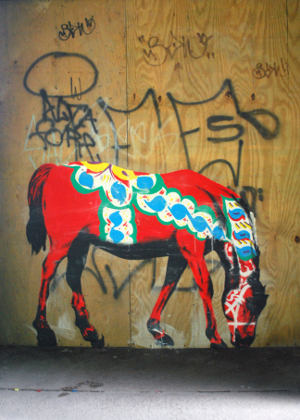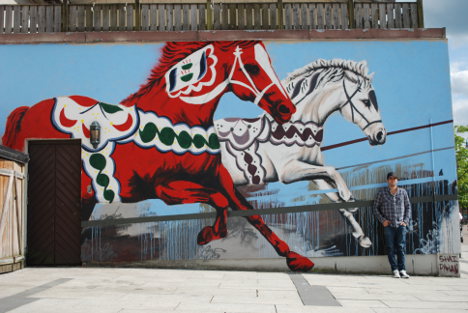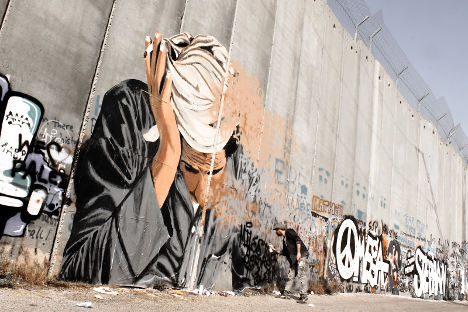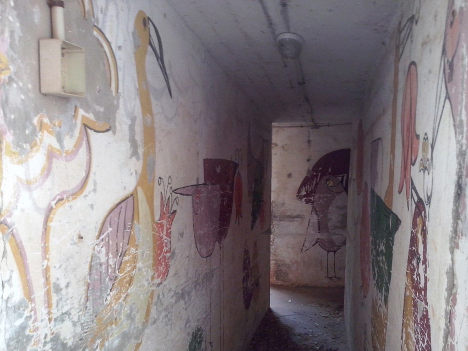Artist rides on back of Dala horse success

Israeli-born American graphic designer and street artist Shai Dahan gained media attention when he painted a Dala horse in his town of Borås. He tells The Local how the criminal act launched his career.
Shai Dahan had participated in street art projects in the US before moving to Sweden but it was in the Nordic country – where the art form is relatively new – that his career as a street artist took off.
As for many other expats, it was a Swedish partner that brought the artist to the country in 2010 after the pair met in New York.
“When I lost my job we had two options: either move back to LA or try Sweden for a while,” he tells The Local.
Attracted by the country's reputation for child care, the couple opted for Sweden, settling in the small city of Borås in the west of the country when his wife was offered a job at a Swedish fashion house there.
But with no knowledge of the language and no contacts, Dahan struggled to find work.
He and his wife agreed that he would take a six-month career break while he tried to figure out what he wanted to do.
It was during this time that Dahan rekindled his love of street art that he had developed in New York. One afternoon in June he stole out to a secluded spot on the side of an office building in Borås where he painted a mural of a realistic Swedish Dala Horse eating grass with the colours and patterns of the traditional wooden statuettes.

The original Dala horse mural that gained Dahan national attention. Photo: Private
It may have measured just half a metre in length but the mural quickly grabbed the attention of residents – eventually ending up on the front page of the local newspaper.
Despite the fact that unauthorized street art is technically illegal in Sweden, Dahan boldly rang up the local newspaper and unveiled himself as the mystery Dala horse painter.
“I thought if the police want to come and knock on my door for putting up cute little horses around town then they should just go ahead and arrest me!”
Encouraged by the enthusiastic reception to the first horse, Dahan continued to put up more of the horses around Sweden – including in Gothenburg and Stockholm – much to the delight of Swedes.
“I think because of people’s attachment to the history of the Dala horse people just fell in love with them.”
He was then invited to exhibit his work at the Modern Art Museum in Borås – making him the first artist with a street art background to have their work shown there.
Later on he was also invited by the city to add a permanent mural of his famous Dala horses – this time legally – in the city centre for the bi-annual International Sculpture Festival.

The Dala horses commissioned for the bi-annual International Sculpture Festival in Borås. Photo: Private
“That just opened doors and private clients started to call me up,” says Dahan.
But the galloping success of the horses had its downside and he found it hard to distance himself from the Dala horses he had become famous for.
“I didn’t just want to be known as the ‘Dala horse guy’,” he says.
The artist found himself thirsting after something more meaningful.
Inspired by the English graffiti artist Banksy who famously painted murals on the wall separating Israel and Palestine in 2005, Dahan decided to go to war-torn region himself.
As an Israeli he was officially forbidden from entering the territory but finally made it thanks to an obliging journalist friend in May 2012. He painted a large five-metre mural of an Arab bedouin on the West Bank Barrier wall in Bethlehem after spending three days there.

Dahan's mural of an Arab bedouin on the West Bank Barrier wall in Bethlehem. Photo: Private
The trip was a turning point for Dahan.
“It changed my motivation and art career. I wanted to create more murals like that.”
Another project included a mural on a 16-floor apartment block in Gdansk, Poland, where he spray-painted a giant pilot.
“Completely coincidentally the street where I painted the mural translated as ‘Pilot Street’ and on the first day of painting a resident told us how there used to be an airport nearby.
“It was good to paint something that connected to the people that live there and it added value to the mural,” he says.
In 2013 he travelled to the deprived Cape Town suburb of Langa in South Africa where, with the help of local school children, he transformed a concrete wall of a youth centre into a colourful mural.
The trip was organized by the Swedish charity Project Playground, founded by models Frida Vesterberg and Sofia Hellqvist, the fiancée of Prince Carl Philip of Sweden.
Dahan’s passion for charitable forms of art can be traced to the artist’s mother, a well-known Israeli water colour and street artist, who first delved into the art form as a young teenager.
“When my mother was thirteen the Six-Day War broke out in Israel and she had to go to a shelter with other children. They weren’t allowed to leave and were anxious about what was happening to their parents outside.”
When the war was over she decided to go back to the shelter and paint it, later going on to paint murals in other shelters and in schools across the country, some of which can still be seen today.

Some of the murals painted by Dahan's mother after the Six-Day War. Photo: Private
The term "street art" was not established in his mother’s time and it was only when Dahan moved to the States in 1989 that he discovered it as a commercialized art form.
As a teenager in LA he became involved in the graffiti scene and when he moved to New York he was invited to participate in street art projects including the Underbelly Project, where over 100 world-famous street artists were invited to paint an abandoned subway station.
Back in Sweden, Dahan now spends about 80 percent of his time earning a living and 20 percent of his time doing charity work, although he admits that he would rather it was the other way round.
Together with his fashion designer wife he started the clothing brand East 39 in 2013, named after the street where the couple lived in New York.
“At first it was just a fun thing on the side but then we started getting phone calls from retailers across Sweden that wanted to stock our clothes.”
Last September Dahan held a solo exhibition in Stockholm, where all the proceeds – around 400,000 kronor – went to Project Playground.
“That’s the kind of stuff that motivates me now.”
He also has time for street art, and has collaborated with the Swedish artists EKTO and Ollio.
But Sweden has its limitations when it comes to street art.
“The laws here are so restrictive. In order to do a mural you have to get permits and permission from building owners as well as make sure the building isn’t historically protected.”
Even so, he says, things are getting better, with events like the No Limits Mural Festival in Borås – curated by none other than Dahan himself – opening doors for street artists like him.
Dahan has no plans to move anytime soon.
“If I was trying to make a living from my art in New York it would be nearly impossible. Here, however, I have a large studio and get jobs on a weekly basis. I’m actually booked 18 months in advance!”
On Friday March 13th Shai Dahan will be exhibiting his work at A GALLERY in Gothenburg (Karl Gustavsgatan 15). Entitled 'Tales of the brave', the exhibition will feature eight new paintings on canvas as well as three on paper.
Comments
See Also
Shai Dahan had participated in street art projects in the US before moving to Sweden but it was in the Nordic country – where the art form is relatively new – that his career as a street artist took off.
As for many other expats, it was a Swedish partner that brought the artist to the country in 2010 after the pair met in New York.
“When I lost my job we had two options: either move back to LA or try Sweden for a while,” he tells The Local.
Attracted by the country's reputation for child care, the couple opted for Sweden, settling in the small city of Borås in the west of the country when his wife was offered a job at a Swedish fashion house there.
But with no knowledge of the language and no contacts, Dahan struggled to find work.
He and his wife agreed that he would take a six-month career break while he tried to figure out what he wanted to do.
It was during this time that Dahan rekindled his love of street art that he had developed in New York. One afternoon in June he stole out to a secluded spot on the side of an office building in Borås where he painted a mural of a realistic Swedish Dala Horse eating grass with the colours and patterns of the traditional wooden statuettes.
The original Dala horse mural that gained Dahan national attention. Photo: Private
It may have measured just half a metre in length but the mural quickly grabbed the attention of residents – eventually ending up on the front page of the local newspaper.
Despite the fact that unauthorized street art is technically illegal in Sweden, Dahan boldly rang up the local newspaper and unveiled himself as the mystery Dala horse painter.
“I thought if the police want to come and knock on my door for putting up cute little horses around town then they should just go ahead and arrest me!”
Encouraged by the enthusiastic reception to the first horse, Dahan continued to put up more of the horses around Sweden – including in Gothenburg and Stockholm – much to the delight of Swedes.
“I think because of people’s attachment to the history of the Dala horse people just fell in love with them.”
He was then invited to exhibit his work at the Modern Art Museum in Borås – making him the first artist with a street art background to have their work shown there.
Later on he was also invited by the city to add a permanent mural of his famous Dala horses – this time legally – in the city centre for the bi-annual International Sculpture Festival.

The Dala horses commissioned for the bi-annual International Sculpture Festival in Borås. Photo: Private
“That just opened doors and private clients started to call me up,” says Dahan.
But the galloping success of the horses had its downside and he found it hard to distance himself from the Dala horses he had become famous for.
“I didn’t just want to be known as the ‘Dala horse guy’,” he says.
The artist found himself thirsting after something more meaningful.
Inspired by the English graffiti artist Banksy who famously painted murals on the wall separating Israel and Palestine in 2005, Dahan decided to go to war-torn region himself.
As an Israeli he was officially forbidden from entering the territory but finally made it thanks to an obliging journalist friend in May 2012. He painted a large five-metre mural of an Arab bedouin on the West Bank Barrier wall in Bethlehem after spending three days there.

Dahan's mural of an Arab bedouin on the West Bank Barrier wall in Bethlehem. Photo: Private
The trip was a turning point for Dahan.
“It changed my motivation and art career. I wanted to create more murals like that.”
Another project included a mural on a 16-floor apartment block in Gdansk, Poland, where he spray-painted a giant pilot.
“Completely coincidentally the street where I painted the mural translated as ‘Pilot Street’ and on the first day of painting a resident told us how there used to be an airport nearby.
“It was good to paint something that connected to the people that live there and it added value to the mural,” he says.
In 2013 he travelled to the deprived Cape Town suburb of Langa in South Africa where, with the help of local school children, he transformed a concrete wall of a youth centre into a colourful mural.
The trip was organized by the Swedish charity Project Playground, founded by models Frida Vesterberg and Sofia Hellqvist, the fiancée of Prince Carl Philip of Sweden.
Dahan’s passion for charitable forms of art can be traced to the artist’s mother, a well-known Israeli water colour and street artist, who first delved into the art form as a young teenager.
“When my mother was thirteen the Six-Day War broke out in Israel and she had to go to a shelter with other children. They weren’t allowed to leave and were anxious about what was happening to their parents outside.”
When the war was over she decided to go back to the shelter and paint it, later going on to paint murals in other shelters and in schools across the country, some of which can still be seen today.

Some of the murals painted by Dahan's mother after the Six-Day War. Photo: Private
The term "street art" was not established in his mother’s time and it was only when Dahan moved to the States in 1989 that he discovered it as a commercialized art form.
As a teenager in LA he became involved in the graffiti scene and when he moved to New York he was invited to participate in street art projects including the Underbelly Project, where over 100 world-famous street artists were invited to paint an abandoned subway station.
Back in Sweden, Dahan now spends about 80 percent of his time earning a living and 20 percent of his time doing charity work, although he admits that he would rather it was the other way round.
Together with his fashion designer wife he started the clothing brand East 39 in 2013, named after the street where the couple lived in New York.
“At first it was just a fun thing on the side but then we started getting phone calls from retailers across Sweden that wanted to stock our clothes.”
Last September Dahan held a solo exhibition in Stockholm, where all the proceeds – around 400,000 kronor – went to Project Playground.
“That’s the kind of stuff that motivates me now.”
He also has time for street art, and has collaborated with the Swedish artists EKTO and Ollio.
But Sweden has its limitations when it comes to street art.
“The laws here are so restrictive. In order to do a mural you have to get permits and permission from building owners as well as make sure the building isn’t historically protected.”
Even so, he says, things are getting better, with events like the No Limits Mural Festival in Borås – curated by none other than Dahan himself – opening doors for street artists like him.
Dahan has no plans to move anytime soon.
“If I was trying to make a living from my art in New York it would be nearly impossible. Here, however, I have a large studio and get jobs on a weekly basis. I’m actually booked 18 months in advance!”
On Friday March 13th Shai Dahan will be exhibiting his work at A GALLERY in Gothenburg (Karl Gustavsgatan 15). Entitled 'Tales of the brave', the exhibition will feature eight new paintings on canvas as well as three on paper.
Join the conversation in our comments section below. Share your own views and experience and if you have a question or suggestion for our journalists then email us at [email protected].
Please keep comments civil, constructive and on topic – and make sure to read our terms of use before getting involved.
Please log in here to leave a comment.